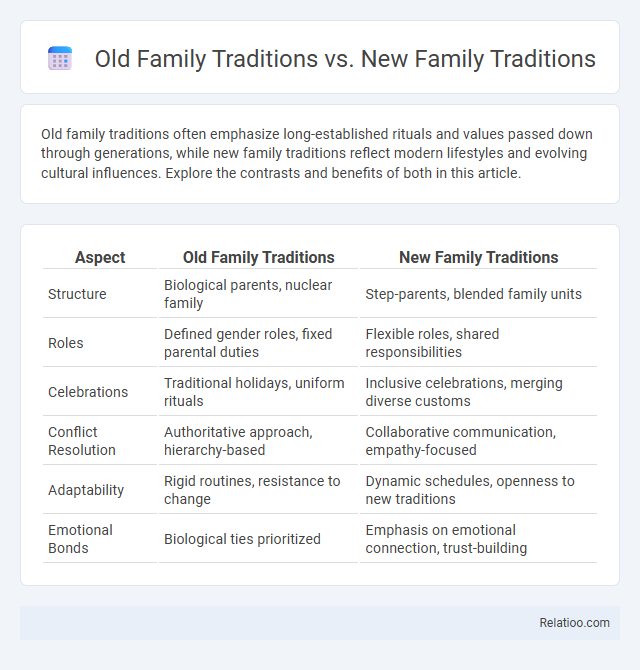Old family traditions often emphasize long-established rituals and values passed down through generations, while new family traditions reflect modern lifestyles and evolving cultural influences. Explore the contrasts and benefits of both in this article.
Table of Comparison
| Aspect | Old Family Traditions | New Family Traditions |
|---|---|---|
| Structure | Biological parents, nuclear family | Step-parents, blended family units |
| Roles | Defined gender roles, fixed parental duties | Flexible roles, shared responsibilities |
| Celebrations | Traditional holidays, uniform rituals | Inclusive celebrations, merging diverse customs |
| Conflict Resolution | Authoritative approach, hierarchy-based | Collaborative communication, empathy-focused |
| Adaptability | Rigid routines, resistance to change | Dynamic schedules, openness to new traditions |
| Emotional Bonds | Biological ties prioritized | Emphasis on emotional connection, trust-building |
Defining Old vs New Family Traditions
Old family traditions often reflect cultural heritage, passed down through generations with rituals such as storytelling, holiday meals, and religious ceremonies, emphasizing continuity and shared identity. New family traditions emerge from modern lifestyles, incorporating contemporary values and technology, such as virtual celebrations, eco-friendly gatherings, and personalized routines. Defining old versus new family traditions highlights the evolution of customs shaped by societal changes, blending historical roots with innovative practices to create meaningful experiences for members across all ages.
The Origins of Traditional Family Rituals
The origins of traditional family rituals trace back to ancient cultural, religious, and social practices that shaped how families celebrated milestones, honored ancestors, and reinforced bonds. Old family traditions often stem from deep historical roots linked to specific ethnic or regional customs, while new family traditions evolve by adapting or blending these legacies with contemporary values and lifestyles. Your understanding of family tradition involves recognizing how these rituals serve to connect generations, creating a sense of identity and continuity over time.
Modern Influences on Family Practices
Modern influences on family practices blend old family traditions with new family traditions, creating dynamic and evolving rituals that reflect contemporary values and lifestyles. Digital technology, cultural diversity, and changing work patterns shape how families celebrate holidays, communicate, and support each other. This fusion promotes inclusivity and adaptability, redefining family tradition to encompass both historical roots and innovative expressions.
The Role of Technology in Shaping Traditions
Technology profoundly influences family traditions by redefining communication and connection methods across generations. Old family traditions often relied on in-person gatherings and oral storytelling, while new family traditions incorporate digital tools such as video calls and social media to maintain bonds despite physical distance. The evolving role of technology allows families to preserve cultural heritage and create innovative shared experiences, blending historical practices with modern conveniences.
Benefits of Preserving Old Family Customs
Preserving old family customs strengthens your connection to cultural heritage, fostering a sense of identity and continuity across generations. These traditions provide a foundation of shared values and memories that can enhance family cohesion and emotional support. Embracing old customs alongside new family traditions enriches the family's collective experience, blending time-honored wisdom with evolving practices.
Challenges of Introducing New Traditions
Introducing new family traditions often faces resistance due to deep-rooted attachments to old family traditions that carry emotional significance and a sense of identity. Your efforts to create fresh rituals may challenge established norms and require balancing respect for heritage while fostering innovation. Navigating conflicts and differing generational perspectives poses significant challenges in harmonizing family tradition evolution.
Bridging Generational Gaps Through Shared Activities
Family traditions serve as vital bridges connecting generations by fostering shared activities that create lasting memories. Old family traditions often emphasize cultural roots and heritage, while new family traditions introduce contemporary elements reflecting current values and lifestyles. Your active participation in blending these traditions strengthens familial bonds and promotes understanding across age groups.
Cultural Shifts and the Evolution of Family Values
Old family traditions often emphasize long-established rituals and customs passed down through generations, reflecting historical cultural values that shaped your family's identity. New family traditions emerge as cultural shifts influence evolving social norms, incorporating contemporary values such as inclusivity, technology integration, and diverse celebrations. Family tradition as a whole adapts dynamically, balancing respect for heritage with the transformation of family values to remain relevant in modern society.
Creating Meaningful New Memories Together
Old family traditions provide a foundation of shared values and memories, while new family traditions allow you to adapt those customs to fit your current lifestyle and interests. Creating meaningful new memories together involves blending time-honored rituals with fresh activities that foster connection and joy for all generations. This balance strengthens family bonds and enriches your collective heritage.
Finding Balance: Blending Old and New Traditions
Family tradition forms the cornerstone of cultural identity, evolving over generations to include both old and new practices that reflect changing values and lifestyles. Finding balance in family tradition involves blending time-honored rituals, such as holiday gatherings and ancestral storytelling, with contemporary customs like digital celebrations or personalized ceremonies. This harmonious integration enriches familial bonds while honoring heritage and embracing modernity.

Infographic: Old Family Traditions vs New Family Traditions
 relatioo.com
relatioo.com